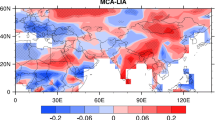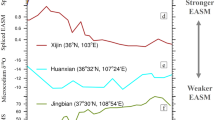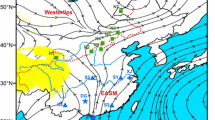Abstract
The rapid warming trend during the last deglaciation triggered significant global climate instabilities due to a complex non-linear response of the climate system to the gradual increase in insolation over the northern hemisphere. Although climate impacts can be detected globally, major regional imprints such as seasonal evolution and changes of the East Asian Summer Monsoon (EASM) during the last deglaciation are still poorly constrained due to a lack of comprehensive proxy data. In this study, we compare how the extreme climate shifts are linked to changes in EASM precipitation over China between the unusually warm Bølling-Allerød (BA) interstadial and the following strong cooling of the Younger Dryas (YD) stadial. Our analysis is based on the transient atmosphere-ocean simulations of TraCE-21ka, in addition to new results from high-resolution simulations of the CESM1 model for the BA and YD time slices. We find that the earlier onset and stronger intensity of the EASM in the BA interstadial lead to more precipitation in early summer (May–June) but drier conditions during mid-summer (July–August) over Southern China compared to a stadial climate during the YD episode. For Northern China, we find the opposite response. The insolation change in spring and the forced response of the atmospheric system are thought to be responsible for these differences. Relative to the YD episode, the hemispheric temperature gradient during the BA period is enhanced due to the asymmetric warming between the two hemispheres, leading to an intensified northward equatorial cross flow. Combined with a stronger sensible heating of the Tibetan Plateau in spring and the related earlier northward shift of the westerly jet, the early onset of the EASM is triggered. The latent heat release, which is accompanied by the onset of the EASM and the sudden increasing precipitation over Southern China in early summer, contributes to the westward shift of the Western Pacific Subtropical High (WPSH) and eastward movement of the South Asia High (SAH) in mid-summer. Under the above conditions, Southern China experiences a hot and dry climate, while Northern China receives more precipitation. Additionally, the La Niña-like pattern of the equatorial Pacific also partly contributes to the strong EASM in the warm period by influencing the WPSH location and Pacific-North American (PNA) teleconnection pattern.











Similar content being viewed by others
References
Alley RB, Clark PU (1999) The deglaciation of the northern hemisphere: a global perspective. Annu Rev Earth Planet Sci 27:149–182
An Z (2000) The history and variability of the east Asian paleomonsoon climate. Quat Sci Rev 19(1–5):171–187
An Z, Porter SC, Zhou WJ et al (1993) Episode of strengthened summer monsoon climate of younger dryas age on the loess plateau of central China. Quat Res 39:45–54
An Z, Colman SM, Zhou W et al (2012) Interplay between the westerlies and Asian monsoon recorded in Lake Qinghai sediments since 32 ka. Sci Rep 2:1–7
Ayliffe LK, Gagan MK, Zhao JX et al (2013) Rapid interhemispheric climate links via the Australasian monsoon during the last deglaciation. Nat Commun 4:1–6
Barker S, Diz P, Vautravers MJ, Pike J et al (2009) Interhemispheric Atlantic seesaw response during the last deglaciation. Nature 457:1097–1102
Björck S (2007) Paleoclimate reconstruction | younger Dryas oscillation. Global Evidence, Encyclopedia of Quaternary Science 2007:1985–1993
Bond G, Showers W, Cheseby M et al (1997) A pervasive millennial-scale cycle in North Atlantic Holocene and glacial climates. Science 278:1257–1266
Broecker W, Bond G, Klas M et al (1992) Origin of the northern Atlantic’s Heinrich events. Clim Dyn 6:265–273
Chen F, Xu Q, Chen J et al (2015) East Asian summer monsoon precipitation variability since the last deglaciation. Sci Rep 5:1–11
Chiang JCH, Fung IY, Wu CH et al (2015) Role of seasonal transitions and westerly jets in east Asian paleoclimate. Quat Sci Rev 108:111–129
Chiang JCH, Swenson LM, Kong W (2017) Role of seasonal transitions and the westerlies in the interannual variability of the east Asian summer monsoon precipitation. Geophys Res Lett 44:3788–3795
Chu G, Sun Q, Zhu Q et al (2017) The role of the Asian winter monsoon in the rapid propagation of abrupt climate changes during the last deglaciation. Quat Sci Rev 177:120–129
Clark PU, Shakun JD, Baker PA et al (2012) Global climate evolution during the last deglaciation. Proc Natl Acad Sci U S A 109(19):E1134–E1142
Dansgaard W, White JWC, Johnsen SJ (1989) The abrupt termination of the YD climate event. Nature 339(15):532–534
Denton GH, Anderson RF, Toggweiler JR et al (2010) The last glacial termination. Science 328:1652–1656
Ding X, Zheng L, Li D et al (2016) Lacustrine record of centennial- and millennial-scale rainfall variability of the east Asian summer monsoon during the last deglaciation: multi-proxy evidence from Taiwan. Palaeogeogr Palaeoclimatol Palaeoecol 450:38–49
Dong JG, Shen CC, Kong X et al (2015) Reconciliation of hydroclimate sequences from the Chinese loess plateau and low-latitude east Asian summer monsoon regions over the past 14,500years. Palaeogeogr Palaeoclimatol Palaeoecol 435:127–135
Duan A, Li F, Wang M et al (2011) Persistent weakening trend in the spring sensible heat source over the Tibetan Plateau and its impact on the Asian summer monsoon. J Clim 24:5671–5682
Duan A, Wang M, Lei Y et al (2013) Trends in summer rainfall over China associated with the Tibetan Plateau sensible heat source during 1980-2008. J Clim 26:261–275
Guo Z, Liu T, Guiot J et al (1996) High frequency pulses of east Asian monsoon climate in the last two glaciations: link with the North Atlantic. Clim Dyn 12:701–709
Ha KJ, Seo YW, Lee JY et al (2018) Linkages between the south and east Asian summer monsoons: a review and revisit. Clim Dyn 51:4207–4227
He F (2011) Simulating transient climate evolution of the last deglaciation with CCSM3. University of Wisconsin 179(1–4):403–420
He J, Liu B (2016) The east asian subtropical summer monsoon: recent progress. Journal of Meteorological Research 30(2):135–155
He F, Shakun JD, Clark PU et al (2013) Northern hemisphere forcing of southern hemisphere climate during the last deglaciation. Nature 494(7435):81–85
Heinrich H (1988) Origin and consequences of cyclic ice rafting in the Northeast Atlantic Ocean during the past 130,000 years. Quat Res 29(2):142–152
Hsu HH, Liu X (2003) Relationship between the Tibetan Plateau heating and east Asian summer monsoon rainfall. Geophys Res Lett 30(20):30–33
Hu C, Henderson GM, Huang J et al (2008) Quantification of Holocene Asian monsoon rainfall from spatially separated cave records. Earth Planet Sci Lett 266:221–232
Huang R, Zhou L, Chen W (2003) The progresses of recent studies on the variabilities of the east Asian monsoon and their causes. Adv Atmos Sci 20(1):55–69
Huang R, Gu L, Zhou L et al (2006) Impact of the thermal state of the tropical western Pacific on onset date and process of the South China Sea summer monsoon. Adv Atmos Sci 23:909–924
Joos F, Spahni R (2008) Rates of change in natural and anthropogenic radiative forcing over the past 20,000 years. Proc Natl Acad Sci U S A 105(5):1425–1430
Karpuz NK, Jansen E (1992) A high-resolution diatom record of the last deglaciation from the SE Norwegian Sea: documentation of rapid climatic changes. Paleoceanography 7(4):499–520
Kelly AL, Passchier S (2018) A sub-millennial sediment record of ice-stream retreat and meltwater storage in the Baltic Ice Lake during the Bølling-Allerød interstadial. Quat Sci Rev 198:126–139
Krishnamurti TN, Ramanathan Y (1982) Sensitivity of the monsoon onset to differential heating. J Atmos Sci 39:1290–1306
Lehman SJ, Keigwin LD (1992) Sudden changes in North Atlantic circulation during the last deglaciation. Nature 356:757–762
Li WP (1999) Moisture flux and water balance over the South China Sea during late boreal spring and summer. Theor Appl Climatol 64(3–4):179–187
Liu D, Wang Y, Cheng H, Edwards RL, Kong X, Wang X et al (2008) A detailed comparison of Asian monsoon intensity and Greenland temperature during the Allerød and younger Dryas events. Earth Planet Sci Lett 272(3–4):691–697
Liu Z, Otto-Bliesner BL, He F et al (2009) Transient simulation of last deglaciation with a new mechanism for bolling-allerod warming. Science 325(5938):310–314
Liu X, Colman SM, Brown ET et al (2014a) Abrupt deglaciation on the northeastern Tibetan Plateau: evidence from Lake Qinghai. J Paleolimnol 51:223–240
Liu Z, Wen X, Brady EC et al (2014b) Chinese cave records and the east asia summer monsoon. Quat Sci Rev 83:115–128
Mayewski PA, Bender M (1995) The GISP2 ice core record—paleoclimate highlights. Rev Geophys 33:1287–1296
Mohtadi M, Prange M, Steinke S (2016) Palaeoclimatic insights into forcing and response of monsoon rainfall. Nature 533:191–199
Nakagawa T, Tarasov PE, Kitagawa H et al (2006) Seasonally specific responses of the east Asian monsoon to deglacial climate changes. Geology 34(7):521–524
Orland IJ, Edwards RL, Cheng H et al (2015) Direct measurements of deglacial monsoon strength in a Chinese stalagmite. Geology 43(6):555–558
Peltier WR (2004) Global glacial isostasy and the surface of the ice-age earth: the ICE-5G (VM2) model and GRACE. Annu Rev Earth Planet Sci 32:111–149
Peterse F, Prins MA, Beets CJ et al (2011) Fossil molecules reveal decoupled warming and monsoon precipitation in East Asia over the last deglaciation. Earth Planet Sci Lett 301:256–264
Porter SC, An ZS (1995) Correlation between climate events in the North Atlantic and China during the last glaciation. Nature 375:305–308
Qian YF, Zhang Q, Yao YH et al (2002) Seasonal variation and heat preference of the South Asia high. Adv Atmos Sci 19(5):821–836
Qiang MR, Li S, Gao SY (2004) Evidence for abrupt climatic changes on northwestern margin of east Asian monsoon region during last deglaciation. Chin Geogr Sci 14(2):117–121
Renssen H, Mairesse A, Goosse H et al (2015) Multiple causes of the younger Dryas cold period. Nat Geosci 8:946–949
Schenk F, Väliranta M, Muschitiello F et al (2018) Warm summers during the younger Dryas cold reversal. Nat Commun 9:1–13
Shen CC, Kano A, Hori M et al (2010) East Asian monsoon evolution and reconciliation of climate records from Japan and Greenland during the last deglaciation. Quat Sci Rev 29:3327–3335
Shinozaki T, Uchida M, Minoura K et al (2011) Synchronicity of the east Asian summer monsoon variability and northern hemisphere climate change since the last deglaciation. Clim Past Discuss 7:2159–2192
Simmonds I, Bi D, Hope P (1999) Atmospheric water vapor flux and its association with rainfall over China in summer. Journal of Climate 12(5 II):1353–1367
Son JH, Seo KH, Wang B (2019) Dynamical control of the Tibetan Plateau on the east Asian summer monsoon. Geophys Res Lett 46(13):7672–7679
Son JH, Seo KH, Wang B (2020) How does the Tibetan Plateau dynamically affect downstream monsoon precipitation? Geophysical Research Letters 47:e2020GL090543
Sun B, Zhu Y, Wang H (2011) The recent interdecadal and interannual variation of water vapor transport over eastern China. Adv Atmos Sci 28:1039–1048
Wang B, Lin H, Zhang Y et al (2004) Definition of South China Sea monsoon onset and commencement of the East Asia summer monsoon. J Clim 17:699–710
Wang H, Brooks SJ, Chen J et al (2016) Response of chironomid assemblages to east Asian summer monsoon precipitation variability in northern China since the last deglaciation. J Quaternaryence 31(8):967–982
Wang W, Liu J, Liu D et al (2000) The two-step monsoon changes of the last deglaciation recorded in tropical Maar Lake Huguangyan, southern China. Chin Sci Bull 45(16):1529–1532
Wang YJ, Cheng H, Edwards RL et al (2001) A high-resolution absolute-dated late pleistocene monsoon record from Hulu Cave, China. Science 294:2345–2348
Wang Z, Duan A, Wu G (2014) Time-lagged impact of spring sensible heat over the Tibetan Plateau on the summer rainfall anomaly in East China : case studies using the WRF model. Clim Dyn 42:2885–2898
Wang B, Li J, He Q (2017) Variable and robust east Asian monsoon rainfall response to El Niño over the past 60 years (1957–2016). Adv Atmos Sci 34:1235–1248
Wei W, Zhang R, Wen M et al (2015) Interannual variation of the south Asian high and its relation with Indian and east Asian summer monsoon rainfall. J Clim 28:2623–2634
Wen X, Liu Z, Wang S et al (2016) Correlation and anti-correlation of the east Asian summer and winter monsoons during the last 21,000 years. Nat Commun 7(May):1–7
Wu G, Liu Y, He B et al (2012) Thermal controls on the Asian summer monsoon. Sci Rep 2:1–7
Wu G, He B, Liu Y, Bao Q (2017) Formation and variation of the atmospheric heat source over the Tibetan Plateau and its climate effects location and variation of the summertime upper-troposphere temperature maximum over South Asia. Clim Dyn 34:1169–1184
Xu D, Lu H, Wu N et al (2013) Asynchronous marine-terrestrial signals of the last deglacial warming in East Asia associated with low- and high-latitude climate changes. Proc Natl Acad Sci U S A 110(24):9657–9662
Yang Y, Yuan DX, Cheng H et al (2010) Precise dating of abrupt shifts in the Asian monsoon during the last deglaciation based on stalagmite data from Yamen cave, Guizhou Province, China. Sci China Earth Sci 53(5):633–641
Yu R, Li W, Zhang X et al (2000) Climatic features related to eastern China summer rainfalls in the NCAR CCM3. Adv Atmos Sci 17(4):503–518
Yuan D, Cheng H, Edwards RL et al (2004) Timing, duration, and transitions of the last interglacial Asian monsoon. Science 304:575–578
Zhan C, Shi Q, Liang S (2019) Assessing the impacts of the spring sensible heat flux over the Tibetan Plateau on Asian summer monsoon rainfall using observational and reanalysis data. International Journal of Climatology:1–17
Zhang R (2001) Relations of water vapor transport from Indian monsoon with that over East Asia and the summer rainfall in China. Adv Atmos Sci 18(5):1005–1017
Zhang Q, Wu G, Qian Y (2002) The bimodality of the 100 hPa South Asia high and its relationship to the climate anomaly over East Asia in summer. J Meteorol Soc Jpn 80:733–744
Zhang Z, Chan JCL, Ding Y (2004) Characteristics, evolution and mechanisms of the summer monsoon onset over Southeast Asia. Int J Climatol 24:1461–1482
Zhang Y, Kuang X, Guo W et al (2006) Seasonal evolution of the upper-tropospheric westerly jet core over East Asia. Geophys Res Lett 33:L11708
Zhou W, Chan J (2007) ENSO and the South China Sea summer monsoon onset. Int J Climatol 27:157–167
Zhou TJ, Yu RC (2005) Atmospheric water vapor transport associated with typical anomalous summer rainfall patterns in China. J Geophys Res 110:D08104
Zhou, W. J., Head, M. J., et al. (1999). Teleconnection of climatic events between East Asia and polar, high latitude areas during the last deglaciation. Palaeogeogr Palaeoclimatol Palaeoecol, 152(1–2), 163–172
Zhou H, Guan H, Chi B (2007) Record of winter monsoon strength. Nature 450:E10–E11
Acknowledgments
We thank the reviewers’ suggestions for improving the manuscript.
Funding
This work is jointly supported by the National Key Research and Development Program of China under Grant Nos. 2016YFA0600504 and 2017YFA0603803, and the National Natural Science Foundation of China under Grants No. 41775073.
Author information
Authors and Affiliations
Corresponding author
Ethics declarations
Conflict of interest
The authors declare that they have no conflict of interest.
Additional information
Publisher’s note
Springer Nature remains neutral with regard to jurisdictional claims in published maps and institutional affiliations.
Rights and permissions
About this article
Cite this article
Kuang, X., Schenk, F., Smittenberg, R. et al. Seasonal evolution differences of east Asian summer monsoon precipitation between Bølling-Allerød and younger Dryas periods. Climatic Change 165, 19 (2021). https://doi.org/10.1007/s10584-021-03025-z
Received:
Accepted:
Published:
DOI: https://doi.org/10.1007/s10584-021-03025-z




